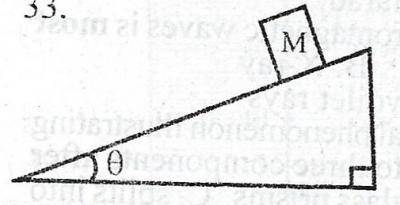
Physics Questions and Answers
If you want to learn more about the nature and properties of matter and energy or you're simply preparing for a Physics exam, these Physics past questions and answers are ideal for you.

If you want to learn more about the nature and properties of matter and energy or you're simply preparing for a Physics exam, these Physics past questions and answers are ideal for you.
250\(ms^{-1}\)
625\(ms^{-1}\)
1200\(ms^{-1}\)
1500\(ms^{-1}\)
Correct answer is C
The fundamental frequency \((f_{0})\) = \(\frac{v}{2l}\)
\(f_{0} = 150Hz; l =400cm = 4m\)
\(150 = \frac{v}{2\times 4}\)
\(v = 150 \times 8 = 1200ms^{-1}\)
When the speed of a car is halved, its kinetic energy is
doubled
quartered
halved
quadrupled
Correct answer is B
Given \(K_{1}\) = \(\frac{mv^{2}}{2}\).
When v is halved, we have
\(K_{2}\) = \(\frac{m\times (\frac{v}{2})^{2}}{2}\)
= \(\frac{K_{1}}{4}\)
Hence, the initial kinetic energy is quartered.

increases
decreases
remain the same
decreases and later increases
Correct answer is B
The velocity ratio and therefore, the mechanical advantage of an inclined plane system increases as \(\theta\) decreases and vice-versa.
50V
100V
200V
400V
Correct answer is C
The ideal transformer (either step-up or step-down) works with the equation:
\(\frac{V_{s}}{V_{p}} = \frac{N_{s}}{N_{p}} = \frac{I_{p}}{I_{s}}\)
where \(V_{s}\) and \(V_{p}\) are the voltages applied to the secondary and the primary respectively
\(N_{s}\) and \(N_{p}\) are the number of turns on the secondary and primary coils respectively
\(I_{p}\) and \(I_{s}\) are the currents flowing in the primary and secondary coils respectively.
\(\frac{V_{s}}{100} = \frac{200}{100}\)
\(V_{s} = \frac{200\times 100}{100} = 200V\)
\(1.11\times 10^{-7} N\) towards P
\(1.11\times 10^{-7} N\) towards Q
\(9.26\times 10^{-8} N\) towards P
\(9.26\times 10^{-8} N\) towards Q
Correct answer is D
\(F= \frac{Gm_{1}m_{2}}{r^{2}}\)
\(m_{1} = 100kg\)
\(m_{2} = 20kg; r =1.2m\)
\(G= 6.67\times 10^{-11}\)
\(F = \frac{6.67\times 10^{-11}\times 100\times 20}{(1.2)^{2}} = 9.26\times 10^{-8}\)
The acceleration of each object is inversely proportional to the mass, the lighter object will move a bit faster, hence. the force will act in the direction of Q.